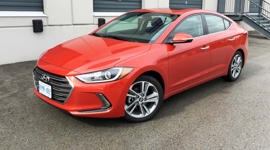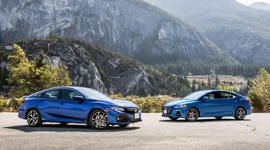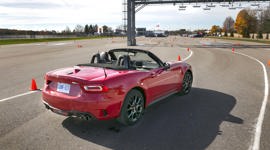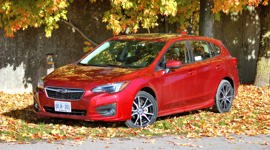Day 1
Perfect timing! autoTRADER.ca is doing a long-term test of the new 2016 Civic, which I had the pleasure of driving a couple of weeks ago. And now this week I'm behind the wheel of the all-new 2017 Hyundai Elantra.
The redesigned 2017 Elantra compact car (with a mid-sized designation) offers a number of class-above, segment-first features, including standard heated front seats and a 2.0L Atkinson cycle engine to achieve better fuel economy. The 2017 Elantra also brings a long list of available technology, including Autonomous Emergency Braking with pedestrian detection, a hands-and-feet-free proximity-activated trunk, heated rear seats, and an Integrated Memory System for the driver seat and exterior mirrors (translation: memory seats).
The big news with the new Elantra seems to be the 'Super Structure' made of 53 percent Advanced High Strength Steel from Hyundai’s captive steel plant - more than double the amount used in the outgoing model’s structure. This new structure provides a slew of advantages over the previous chassis, including a quieter cabin and a better crash structure. Hyundai also claims this stronger chassis has improved driving dynamics (stiffening a chassis usually does that), so it most likely does as claimed.
My tester is a Limited version, which is well equipped, including leather seats, an eight-way power-adjustable driver seat with memory settings, an Infinity 315W audio system with eight speakers, 8.0-inch touchscreen with navigation and Android Auto, 4.2-inch colour TFT cluster display, LED tail lights, Rear Parking Assist System, and auto-dimming rear-view mirror with HomeLink.
Model: 2017 Hyundai Elantra Limited
Pricing: $26,249
Options: None
Freight: $1,695
A/C Tax: $100
Price as Tested: $28,044
Competitors:
Chevrolet Cruze
Ford Focus
Honda Civic
Kia Forte
Mazda3
Nissan Sentra
Toyota Corolla
Volkswagen Jetta
Day 2
One of the most important parts of an interior to me is how intuitive it is to use. How quickly can I access everyday features and for someone that jumps from car to car, how intuitive are these features to use? When I picked up the new Hyundai Elantra on Monday the first thing I did was search for the seat heater button as the leather was cold.
Thankfully it was super easy to spot, right beside the shifter, where it should be and remarkably beside that was the heated steering wheel button -- oh my luck! So I hit that button too. Next was the radio, it was far too loud, a quick spin of the knob and the volume was lowered and a quick flip of the switch and the sunroof that was left open was closed.
This may all seem simple and basic, but so many cars these days are moving towards touch screen controls and touch sensitive controls for volume, cough... Honda ... cough, I welcome the simplicity and ease of use.
I also immediately noticed the centre armrest was able to both open and extend to offer more support to my elbow and the steering wheel adjustment was easy to reach and adjust, cough... Honda ... cough. The interior build quality is a mix of soft and hard plastics, about on par for the class of vehicle. The door panels are probably the cheapest looking part of the interior but overall nothing really exciting disappointing for the price point.
The seats are a little flat for my liking though and offer nearly zero side bolster support and the leather just doesn't have a pleasurable feeling to it, although it is perforated which means less chance of getting all sweaty in the summer.
Day 3
After using the trunk today I noticed one major thing that seems to be missing on most of this segment but Hyundai deserve major props for adding it. It's a small thing but it makes a world of difference in our yucky salty climate: a handle to grab and close the trunk by from the inside. Thank you Hyundai.
Everyone wants to know how the Atkinson cycle 2.0L engine performs in a non-hybrid setup. It is also noted that Hyundai has reduced power output (about 30 hp less) in this 2.0L compared to the outgoing model, now down to 147 hp and 132 lb-ft of torque in order to achieve improved fuel economy.
The biggest thing I've noticed with this engine is its performance when cold, the actual power output seems greatly reduced. When you first start the car in the morning and head out, the engine sounds extremely course and acceleration is very tepid. At first I thought this was purely in my head the first day but after three days now I am pretty confident in what is going on here.
Once the engine gets up to temperature though it really comes to life, it revs smoother it pulls stronger and feels great. In fact it feels way more powerful than the advertised specifications. When you apply even just mild throttle around 2,200 - 2,500 rpm there is a surge of torque you would not expect from a small engine like this. Dare I say the engine feels underrated?
Hyundai has certainly improved their suspension or perhaps it is also their superstructure that has reduced suspension "clunk" over bumps. The suspension is both compliant and firm and does not clunk anymore unless you over extend it over extremely large potholes. I zipped over a set of train tracks that cause some cars to lose their composure and the Elantra flew over, barely even registering them.
The only complaint I have is the road noise -- this could be attributed more to the winter tires on my tester. The Civic I drove a few weeks ago had winter tires (ones that were horrible in the snow by the way) but road noise was less than that of the Elantra.
Day 4
The new less "stylistic" and more grown up looks of the Elantra make it more appealing to me and to many whom I've talk to over the week with the car. A lot of people commented on how it looked a lot more "grown up" but also a lot larger than they would expect an Elantra to be. That could be good or bad depending on your point of view I guess.
Of course everyone wants to know how the Elantra treated me at the gas pumps. According to the onboard computer I averaged 6.5 L/100 km over the week, according to my hand calculations I averaged around 7.0 L/100 km so I'd venture to say the computer is most likely more accurate. In comparison when I drove the new 2016 Civic with the 1.5L Turbo a couple of weeks back I averaged 7.5 L/100 km but to be fair it was much colder then.
So in the end we have a new car that is quieter, handles better and is more fuel efficient than its predecessor. Which is exactly what Hyundai told me (and advertises) about this new Elantra. So they aren't lying, at least not based on my testing over the week. It's a grown up compact car that I'd be happy to have as a daily commuter if I'm honest -- it was that good.
























